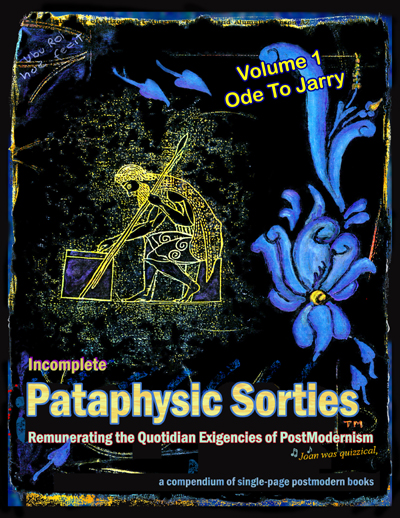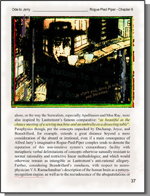
Pataphysic Sorties
Volume One
Ode to Alfred Jarry
 Man Ray’s Enigma of Isidore Ducasse, is one of the best-known among definitive Surrealist sculptures, and like much of Apollinaire’s writing, was inspired by Comte de Lautreamont’s famous comparative: “as beautiful as the chance meeting of a sewing machine and
an umbrella on a dissecting table.” Though Alfred Jarry affected a wilding Rogue-Pied-Piper persona, his careful work in deconstructing rationality itself, particularly its verbal forms, was fundamental to the postmodern
ideas and sculpture of Rene Duchamp, postmodern literature like that of James Joyce, and the postmodern social critiques of Jean Beaudrillard, among many others.
Man Ray’s Enigma of Isidore Ducasse, is one of the best-known among definitive Surrealist sculptures, and like much of Apollinaire’s writing, was inspired by Comte de Lautreamont’s famous comparative: “as beautiful as the chance meeting of a sewing machine and
an umbrella on a dissecting table.” Though Alfred Jarry affected a wilding Rogue-Pied-Piper persona, his careful work in deconstructing rationality itself, particularly its verbal forms, was fundamental to the postmodern
ideas and sculpture of Rene Duchamp, postmodern literature like that of James Joyce, and the postmodern social critiques of Jean Beaudrillard, among many others.
Many have noted the multiple currents of anti-Rationalism slash anti-linearity which proliferated at the end of the Nineteenth Century, among which are Jarry’s work, as well as the stunning non-Euclidian geometries relied upon by Einstein; (with parallel lines which actually do meet each other), and of course the irrationality of Heisenberg’s Uncertainty Principle, to say nothing of the rest of emerging quantum physics and its irrational a-causal logic.

It’s impossible to over-emphasize the huge influence this onslaught of anti-rational media had on the tenor of postmodern personal identity and postmodern conceptualization in general, across the industrial West. Rational Carolingian Positivism, with roots running back to Euclid and his conceptualized geometry of parallel lines, had controlled Western thought for a millennium; and had re-made the world with its new rational epistemologies, empirical science and resultant industrialization.
Beaudrillard has perfected Kant. Kant complained that our mind mediates between us and noumenal reality. He complained that we can’t know truth because we can’t contact reality directly. Beaudrillard says we contemporary postmoderns are divorced from reality because our minds have conceptualized everything to the extreme. We’ve reconceptualized everything (people, institutions, relationships, histories…) into a network of ethereal imaginings and assumptions he calls the Simulacrum. It’s like kind of a Las Vegas pastiche of reality he says. The Simulacrum is a make-believe world he says; but we all take this conceptualized artifice for actual reality. Like Lao-Tze, Beaudrillard holds conceptualism to be addictive and undesirable.
Beaudrillard’s Simulacrum is a conceptually-constructed, reality that we take for genuine. But it’s not genuine; it’s a fictitious non-parallel track – according to Beaudrillard.
THIS BOOK IS CURRENTLY AVAILABLE ONLY AS A FREE .pdf DOWNLOAD